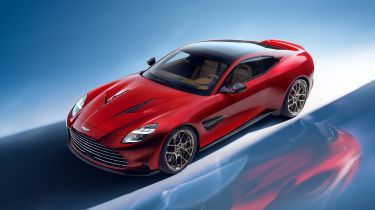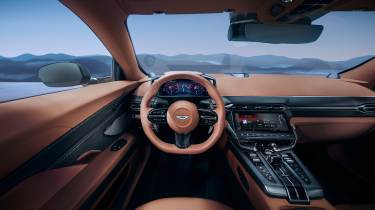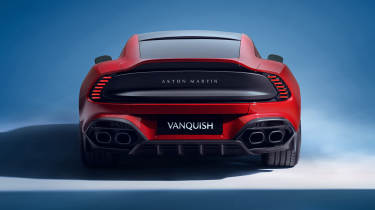New Aston Martin Vanquish unveiled with roaring 823bhp V12
The British brand’s third major sports car update in two years sees the Vanquish nameplate return
Aston Martin has just raised the stakes once again with its next flagship front-engined sports car, relaunching a much loved nameplate in the process. The new Aston Martin Vanquish features lots of headline-grabbing numbers, including packing the most powerful iteration of the 5.2-litre V12 engine yet, as well as a whole new body, uprated chassis and a luxurious new interior.
As Aston’s flagship series-production front-engined model, though, it’s also impossible not to compare it to Ferrari’s new 12Cilindri, reigniting a generations-long battle between the two iconic sports car manufacturers.
Sitting above the recently renewed Vantage and DB12 in the Aston line-up, the new Vanquish is available to order now from ‘around’ £333,000, with Aston Martin building no more than 1,000 units every year.
Engine and transmission
A highlight of the new Vanquish is the retention of Aston’s 5.2-litre twin-turbocharged V12 engine, which now produces 823bhp and 1,000Nm of torque.
Compared with the Ferrari, this is a very slight 5bhp increase, but thanks to the Aston’s turbochargers the Vanquish has much more torque. As a result, the Ferrari makes do with a not insubstantial 322Nm deficit. The Aston’s torque is also available much lower down in the rev range, from 2,500rpm all the way through to 5,000rpm.
The way Aston Martin has generated this extra power goes right to the core of the V12 engine’s engineering, starting with a reinforced cylinder block. Plus, both the exhaust and intake ports have been redesigned, the spark plugs repositioned and new, high-flow injectors fitted.
The top end has also been fundamentally redesigned, thanks to a new set of camshafts, plus there are new turbochargers that reach higher speeds and have less internal inertia than the ones previously used. For the first time, there’s also a new Boost Mode that will increase the turbos’ respective boost pressures for more power under part-throttle.
Power is sent to the rear wheels via an eight-speed ZF automatic gearbox, in contrast to the Mercedes-sourced nine-speed units you’ll find in the Aston Martin DBX SUV. Aston has also combined the ZF box with an electronically controlled limited-slip differential on the rear axle.
All of this explains the quite astonishing performance on offer in the new Vanquish, including a 3.3 second 0-62mph time and a 214mph top speed. Compared with the Ferrari, the sprint to 62mph takes 0.4 seconds longer, but the Aston’s top speed is higher, with its rival only quoting a figure of ‘more than’ 211mph.
What the numbers won’t tell you, however, is where the cars might differ in terms of character, because the Aston’s turbocharged engine won’t scream its way to quite such a high red line as the Ferrari’s naturally aspirated V12 engine.
Body and chassis
Alongside substantial changes under the bonnet, Aston has also been busy with the car’s body and chassis. The key figure here is the extra 80mm in the Vanquish’s wheelbase that the company says has been placed between the A-pillar and front axle.
This means that while the new Vanquish is a long car for a coupe, at 4,850mm, its cabin is still strictly for two. In comparison with the Ferrari, the Aston is nearly 12cm longer, and 214kg heavier, with a 1,774kg dry weight.
To help offset some of the mass, the Aston Martin’s bodywork is fully constructed of carbon fibre and sits on top of Aston’s usual bonded aluminium structure. The suspension is double-wishbone up front, with a multi-link rear set-up, and employs new-generation Bilstein DTX dampers that Aston says dramatically widens the ride’s bandwidth between firm and supple.
Further enhancements to the chassis see big increases in torsional stiffness, including a 75 per cent increase in lateral stiffness compared with the outgoing DBS. This is achieved through stiffer bracing at the front and rear of the chassis, new plating underneath the front axle and higher levels of lateral stiffness across the rear suspension towers. The wheels are a set of super-lightweight 21-inch forged alloys, wrapped in a unique Pirelli PZ4 compound designed specifically for the new Vanquish.
Being a top-spec Aston, the 410mm front and 380mm rear brake discs are carbon ceramic as standard, and reduce the unsprung weight by 27kg, compared with an equivalent set of steel brakes.
Design and interior
All of this upgraded hardware is covered by the new Vanquish’s larger body. Designed under the leadership of Marek Reichmann, the DBS follows a similar path to other new Aston Martins in increasing the size of the grille opening and simplifying its body lines. Unlike the last DBS, which shared some body panels and its glasshouse with the DB11, the new Vanquish is totally bespoke.
The front end is dominated by that huge new grille, which is 13 per cent larger and sits between two smaller ducts at either side that funnel cooling air to the brakes. Just like the DB12 and Vantage, Vanquish has ditched the front clamshell for a more traditional inset bonnet, and swapped the old DB11-based floating roof for a simpler design. Along the car’s flank is a new opening and formed strake inside that, but it’s the back that sees the greatest departure.
Here, Aston has fitted a classic Kamm-style rear end, with a distinctive shorn-off appearance and tiny, bespoke LED lamps. The body’s inner section can be finished in either carbon fibre or body colour, and appears to float within its surround. Below sit four huge exhaust outlets, which hide an optional titanium exhaust back-box that increases the noise and reduces the car’s overall weight by 10.5kg over the standard-fit system.
Inside, Aston has used the same collection of controls as other modern Astons, including the new and much improved infotainment system. But they all sit within a new dashboard with a redesigned centre console. The space behind the front seats is reserved for fitted luggage, and helps liberate a reasonably sized 248-litre boot space behind – both of which highlight the Vanquishes grand touring abilities.
Which is where the Aston diverges from the more overtly sporty Ferrari. Aston Martin has specifically designed the new Vanquish to have more of a dual purpose. It might be a two-seater, but Aston’s big new flagship is arguably more GT-like than any of its direct predecessors, leaving plenty of room above it in the company’s range for something far more sporty and, more likely, mid-engined.
Do you like the new Vanquish? Tell us your thoughts in the comments section below...
Find a car with the experts










